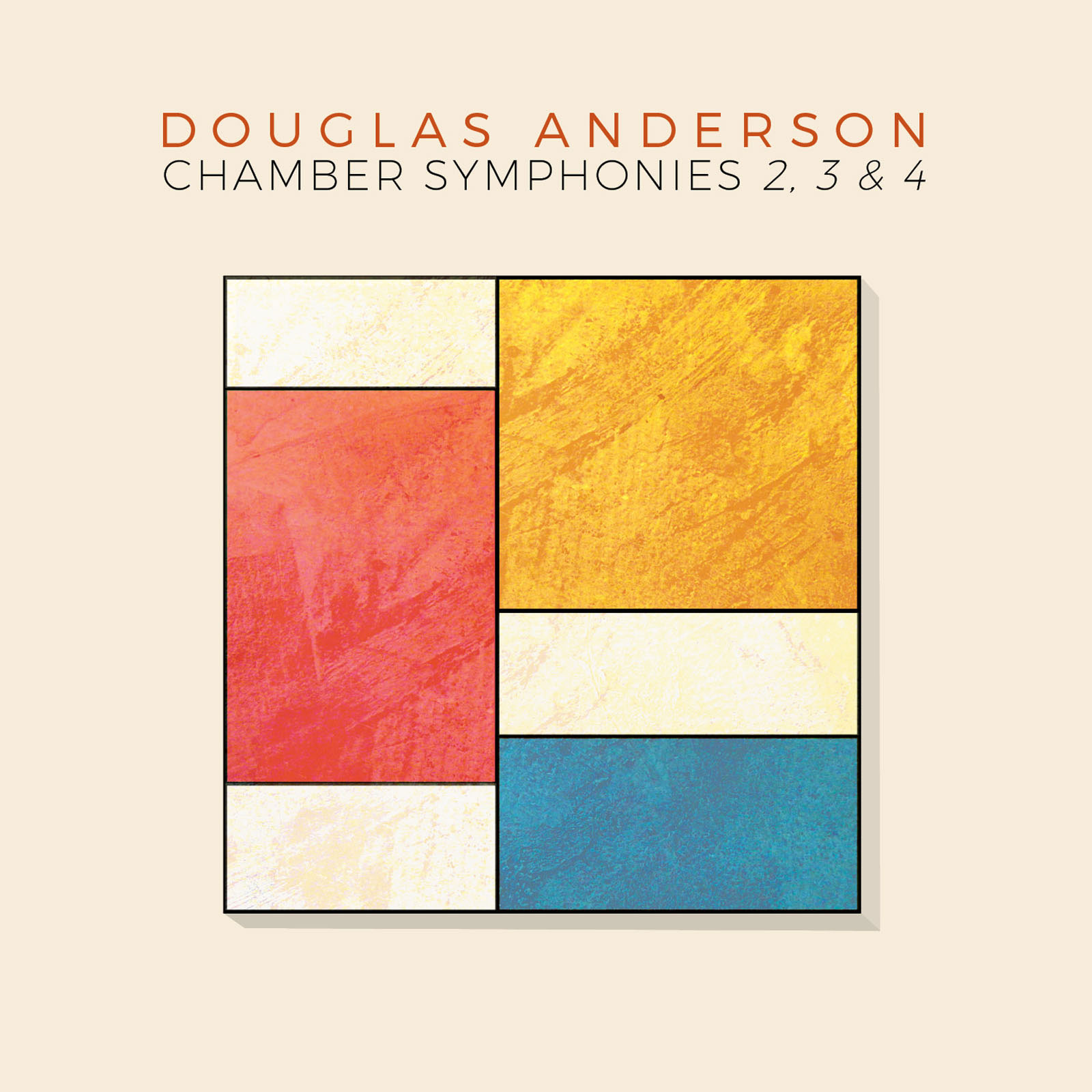Chamber Symphonies 2, 3 & 4
Since the robust development of the symphonic form in the 18th century, many composers, from Haydn, Beethoven, Mahler and Stravinsky, have written within the genre, creating engaging sonic worlds in and of themselves. Inspired by Arnold Schoenberg’s two chamber symphonies, American composer Douglas Anderson presents three of his chamber symphonies on his debut release on Ravello Records, which aim to envelope the listener in a varied and multifaceted musical environment all the while exploring the genre using the necessarily limited timbral and harmonic palette of a small ensemble.
Each of Anderson’s three-movement chamber symphonies was written for a particular ensemble, deriving pitch material from the characteristics of the instruments. Chamber Symphony No. 2 (1989) was written for Oval Window Chamber Ensemble and premiered in 1989 at Weill Recital Hall at Carnegie Hall. Written for flute, clarinet, violin and cello, this work incorporates elements and characteristics from a variety of composers, from Mozart and Josquin Des Prez to Shostakovich. Chamber Symphony No. 3 (2001), written for and premiered by Eight Strings & a Whistle, features a short cadenza between the movements for each of the instruments – flute, viola, and cello – providing momentum leading up to an intense climax. Anderson’s Chamber Symphony No. 4 (2011) was written for the di.vi.sion piano trio and uses two serial rows, which are made more and more complex through a series of variations. The composer magnifies the scope of the symphonic form, taking it out of its traditional context and restraining it to a smaller ensemble only to open up new realms in chamber music repertory.
Compositions Featured on this Album
Notes from the Composer
These three works were written on request for particular ensembles which happened to be populated by colleagues and friends. They were familiar with my compositions, and each had a need at the time for a significant work in their repertoire. I get these commissions often enough to keep me busy, so as usual I asked them what kind of piece they wanted, what other works might be on a program with it, and other such questions to narrow down the options. In each of these cases this discussion led me toward the creation of a chamber symphony. I had complete confidence in writing for musicians I respected and admired, and I took great gleeful pleasure in creating music that would be challenging and entertaining for them to perform.
A composer’s task is to present their listeners with music that does the diverse things we humans have discovered that music can do: entertain, energize, relax, excite, depress, amuse, entrance, confuse, clarify, change moods, provide spiritual experiences, and so on, all the way to making the hair stand up on the back of your neck. Maybe not everything in every piece, but composers should have their goals clearly in mind as they ply their craft. These symphonies, as they go about their musical business, try to do some of those things. Touching on various issues and presenting various musical environments, they each lead the listener on an aural path of my design, and hopefully by the end through a sequence of musical experiences that concludes coherently and satisfyingly.
After having the opportunity as a student to conduct several orchestral symphonies by great composers, I also had the chance to study and conduct Schoenberg’s two Chamber Symphonies, and became interested in the different compositional possibilities that they introduced me to. As a result, one of my last student works before my doctoral dissertation was a chamber symphony (No. 1). I learned much from that experience, so when asked by these ensembles to write pieces for them, I chose to continue to explore the genre. Thus in 1989, 2001, and 2011 were born my Chamber Symphonies 2, 3, and 4.
I think, as others before me have, that the title ‘symphony’ implies a large work touching on a variety of musical issues, but with an underlying cohesion that pulls all the diverse ideas together by the end. So a chamber symphony, as I write it, does this. These works are symphonies because like their larger orchestral cousins, they are works that create varied and multifaceted musical worlds, but given the small number of instruments involved, with a necessarily limited timbral and harmonic palette. I have chosen in these pieces to use a plan of three connected movements, rather than the four separate movement plan of traditional orchestral symphonies; Schoenberg introduced me to the flexibility of chamber symphony form (as well as his profoundly adaptable serial system, see below), and this three movement sequence, with connecting cadenzas and an extended coda, provided me with the structural platform best suited to the exploration of the musical ideas involved.
On the Compositional Techniques Employed in Chamber Symphonies 2, 3, & 4:
In these three particular works I have chosen to follow the old tradition of Western art music of having pitch events (melodies and harmonies) as the primary focus. The pitch materials for these melodies and harmonies are derived in each case from the pitch characteristics of the instruments themselves. These characteristics, which can range from the pitches of the open strings, high and low notes of the instruments, harmonics, etc., are combined and recombined to create serial (that is, ordered) rows, which in turn are then manipulated and modified in both quasi-tonal and traditional serial (a la Schoenberg, et al.) ways to bring out some of the variety of possibilities present.
One of the compositional methods I have explored since my student days (indeed, it was the subject of my doctoral dissertation) concerns the loosening of strict serial ordering, or ‘unordering’ as I call it, which allows the row to then function more like a scale does in traditional tonal music. But these ‘scales’, having been initially drawn from an ordered row (and usually presented as such at some point in the piece), can leave a residue in the listener’s mind of certain melodic or harmonic sequences, which then can be used as motives or chord progressions, becoming the building blocks of form.
Certain elements of the original rows are also used to create tonal centers, and the attraction, resistance, and resolution found in the great tonal music of the past can be thus recreated, but now using completely different (i.e., non-diatonic) musical resources and procedures. Sometimes these ‘scales’ (or pitch sets) are presented first in a completely unordered way, then gradually find their ordering as a traditional serial row; sometimes the ordering is presented first, then gradually discarded in favor of other kinds of (less ordered) pitch connections; and so on into the great variety of possibilities.
The durational aspect of the sounds (rhythm and tempo) are usually used here to enhance and develop the pitch ideas, and timbre and dynamics then become the amplifiers of all these ideas, in search of the intellectual, emotional and physical experiences mentioned above.









